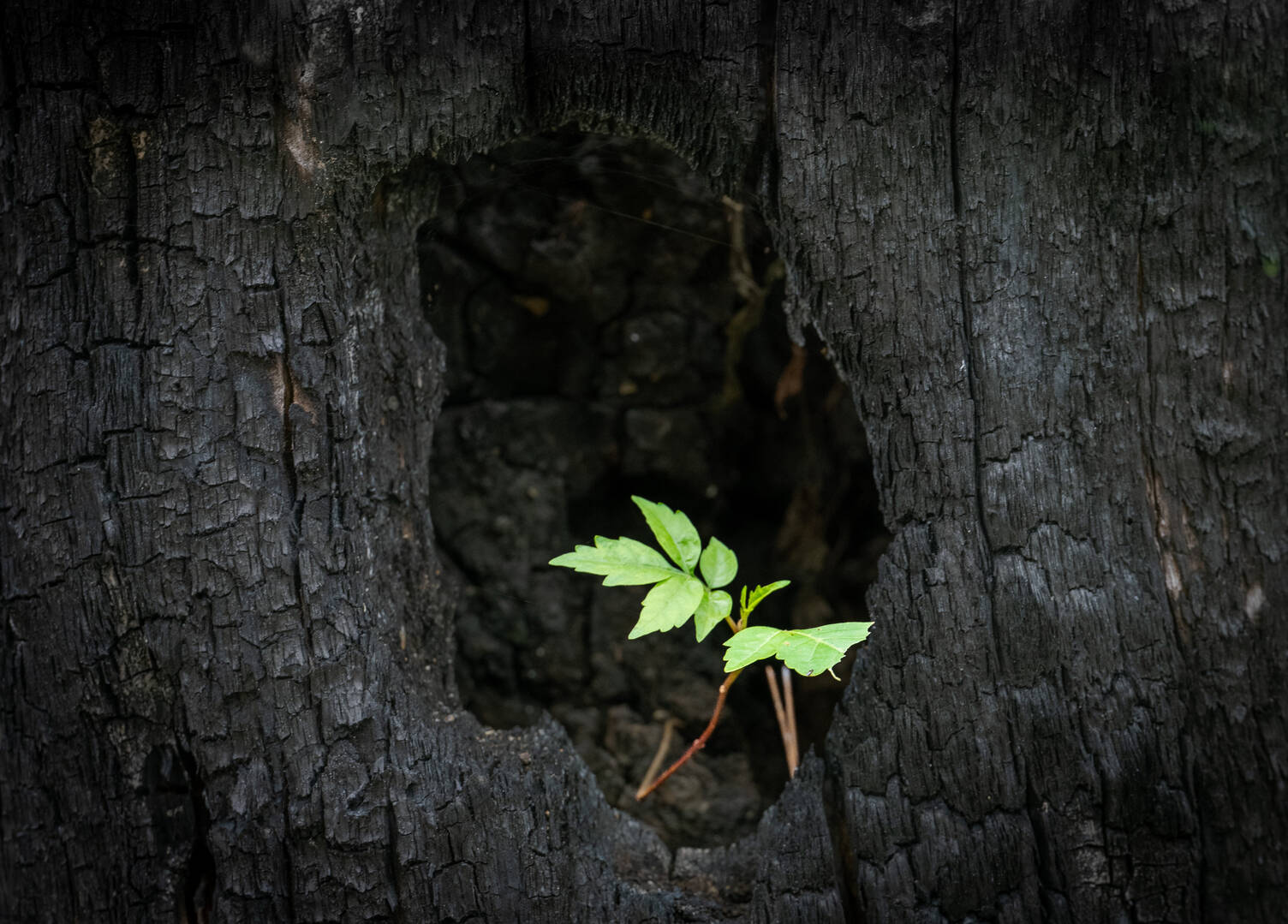Photography has a special magic for me. It is only thanks to it that I can suppress my comfortable and lazy side and face annoying insects, lack of food, or bad weather. A few days ago, in anticipation of beautiful morning views of the surrounding landscape, I rejected the comfort of the forest canopy and instead hung my hammock on the top of a high rock. Gusty winds whipped my bed so hard that I felt like a Tibetan prayer flag. But the next morning proved once again that the greatest reward comes after a little hardship.

Recent Announcements
- Tamron 28-300mm f/4-7.1 Di III VC VXD: A 10.7x zoom lens compatible with Sony E-mount full-frame mirrorless cameras. A lens for those who prefer an all-in-one solution. In addition to covering a wide range of focal lengths, the advantage is the relatively light weight (610g) and compact dimensions (126mm long; 67mm filter thread). The stabilized lens offers unusual close-focus capabilities at the wide end, with a minimum focusing distance of 0.19m (and 1:2.8 magnification) at 18mm. The moisture-resistant construction includes 20 elements in 13 groups, with weather-exposed surfaces protected by a fluorine coating. Uncommon for this lens category is the focus set button. Available starting August 29th for $899.
- Meike 33mm f/1.4: Where there is no will from the original manufacturers, there is an opportunity for third-party alternatives. That description applies to APS-C lenses from every company except Fujifilm. The Meike 33mm f/1.4 thus offers another fast prime 50mm equivalent lens for cameras with Sony E, Nikon Z, and Fuji X mounts. Autofocus is provided by an STM motor. On the body of the lens we find the AF/MF switch, focus ring, aperture ring and USB-C port for possible firmware updates. The lens accepts 55mm diameter filters and weighs 314g. Available on August 15th for $230.
- Atomos Shinobi II HDMI Monitor: This second-generation monitor comes with a display that has been enlarged from 5″ to 5.2″ while maintaining the 1920 x 1080 resolution. The device is still very light (210g) and compact (151mm x 91.5mm x 20.8mm). Compared to its discontinued 5″ predecessor, the brightness has increased significantly from 1000 to 1500 cd/m². Perhaps the most welcome improvement, however, is the ability to control the camera directly via the monitor using USB-C. Currently, this feature is only available for Canon, Panasonic, and Sony cameras, but more are expected via future firmware updates. The price is $349.
- Lexar Professional Go Portable SSD with Hub: Two devices in one that will be especially useful for iPhone 15 Pro users, who will be able to shoot video up to 4K Apple ProRes and 60p. (Without an external SSD, the frame rate is limited to 30p.) The maximum SSD capacity is up to 2TB in just 1.71 x 0.98 x 0.32 inches. Its closest friend is the Hub (2.71 x 1.71 x 0.32 inches), which has four USB-C ports to connect other accessories such as microphones, a power bank (30W PD), and the like. The units are dust and water resistant (IP65). Available on Kickstarter starting at $129 for the 1TB version (without the Hub) or $159 for the 1TB SSD combo with Hub.
The Rumor Mill
Canon EOS R6 Mark III in the home stretch?
It’s the Olympics, so I’m going to use a little sports terminology. It’s quite possible that the home stretch for the Canon EOS R6 Mark III release is going to be quite long, so keep the champagne in the cooler for now. But rumors right now suggest that this highly anticipated camera could cross the finish line as early as this year. What do our TV analysts say about the specifications? The resolution should remain the classic 24MP, but the sensor should be “related to the stacked” one on the R3. However, it is not expected to borrow the eye-controlled AF feature of that camera. As for video, the frame rate should increase to 120p for 4K and 240p for Full HD.
Via Canon Rumors
Macroscopic patents from Canon
If you’ve ever tried to take close-up photos of living creatures, you’ve probably encountered some cooperation problems from them. The working distances of traditional macro lenses are in the order of centimeters, sometimes even less. This requires extremely brave subjects who aren’t afraid of a lens that often exceeds their body size many times over. Canon seems to be aware of this problem, which has resulted in some interesting patents for macro photography telephoto lenses. Among them are a Canon RF 180mm f/3.5 Macro (two versions, one of which comes with TC support), a 300mm f/4 Macro, a 190mm f/4 2x Macro, and a more traditional 110mm f/4 Macro. Unfortunately, we don’t know which of these patents will make it into production, if any. Which one would you like to see?
Via Canon Rumors
Expected third-party primes for Nikon Z-mount
The range of original lenses for Nikon Z-mount is quite large and only growing. However, this is mainly true for full-frame lenses. In the APS-C lens segment, their range resembles the drum notes in classical music. That’s why some of you might be happy to know that Yongnuo is about to announce a 23mm f/1.4 Z APS-C lens. And it should be here as early as this week, August 7th to be exact. This will give Nikon APS-C cameras (and with them Sony and Fuji) another versatile reporter’s classic equivalent to 35mm. Other lenses coming soon are a Viltrox 28mm f/4.5 pancake and a Meike 35mm f/2.
Via Nikon Rumors
Good Deals and New Sales
The Sony Summer Deals are running at B&H Photo right now. I’ve been checking out what interesting products you can get for a good price, and here are the ones that caught my eye:
Cameras
- Sony a7R V (was $3,898, now $3,498)
- Sony ZV-E1 (was $2,198, now $1,898)
- Sony a6600 (was $1,198, now $998)
- Sony a7 IV (was $2,498, now $2,298)
- Sony a7R IVA (was $3,198, now $2,998)
Lenses
- Sony FE 24-105mm f/4 G OSS (was $1,298, now $1,098)
- Sony FE 20-70mm f/4 G (was $1,098, now $998)
- Sony FE 200-600mm f/5.6-6.3 G OSS (was $1,998, now $1,898)
- Sony FE 24-70mm f/2.8 GM (was $1,698, now $1,598)
- Sony FE 70-200mm f/4 G OSS (was $1,198, now $1,098)
- Sony FE 100-400mm f/4.5-5.6 GM OSS (was $2,498, now $2,398)
- Sony E 16-55mm f/2.8 G (was $1,398, now $1,298)
Memory cards
- Sony 640GB CFexpress Type A TOUGH (was $998, now $798)
- Sony 960GB CFexpress Type A TOUGH (was $748, now $548)
- Sony 320GB CFexpress Type A (was $648, now $468)
- Sony 256GB SF-G TOUGH Series UHS-II SDXC (was $398, now $298)
- Sony 512GB SF-M Tough Series UHS-II SDXC (was $228, now $188)
Other Pages of Interest
The Olympics run like a thread through this week’s Photography News, and the interesting articles that I have for you this week are no exception. Perhaps the most visually stunning photo from this year’s Olympics was taken by Jérôme Brouillet in the waves off the island of Tahiti, where the surfing competition is taking place. His photo of a seemingly levitating Gabriel Medina is breathtaking. On CBC News, you can hear the author himself explain how he took the photo.
Another photo from the Olympics may not be very interesting visually, but it carries a strong message. An important feature of sport, and one of the fundamental ideas of the Olympics, is to unite people and nations. And although there is bitter hostility between North and South Korea on the political front, there seems to be a much warmer relationship on the sporting one. At least this selfie of two gymnasts from the two rival countries shows that. See this moment on the Time website.
We are not leaving the world of competition; we’re just changing the discipline. This week, the BBC website featured the results of the Mangrove Photography Awards. Few ecosystems have had such a difficult time in recent decades as this one. Despite its immense ecological importance, many people still think of it as a mosquito-infested swamp. That is why contests like this are so important for public education. Well, and I am very pleased to announce that a member of our team, Nicholas Hess, has won the Young Mangrove Photographer of the Year award. Congratulations on a great achievement, Nico!
Photo Theme Challenge, Week #61
Last week’s theme was partially hidden, and you can see the results in this thread. Thank you to everyone for your submissions! This week’s theme is landscape, and you can submit your results in this thread by Saturday, August 10, 2024!
Week #60 Results
Let’s check out some of the shots we received for the “partially hidden” theme, starting with vidmarko’s photo:

Here we have a classic ‘hidden by shadows’ look. Nice!
Net let’s check out Tom Pazol’s photo:

In this case, the garden hides much of the scene of skyscrapers in the background. I think I’d rather be in the garden!
Finally we’ve got Bhoward’s photo:

Here, the tree provides the perfect framing for the starting of a new tree and hides it from the elements.
Thanks everyone for submitting their photos in the challenge, and we hope to see more next week in the landscape theme.
I’ve been with Nikon for 20+yrs, but a 300 mm macro (1:1) from Canon will make me think about it. I’m having fun with the Sigma 180 mm 2.8, but this will be an extra step for insects. I was waiting Laowa producing something similar (there’s nothing longer than 105 mm on the market (new) and it took me quite some time to find an used copy of the 180 mm from Sigma for Nikon F).
A 300mm f/4 macro would be truly cool if 1:1. I would looooove a lens like that. I’ve been thinking about a project with birds eyes and I think this would be a great lens to have.
I totally agree. 300mm macro would be a game changer. If it also supported teleconverters, it would be beautiful. Such a lens would nicely fill the hole between 120mm and 500mm that currently yawns in my arsenal. By the way, bird’s eyes are a great idea. The feather structures are also beautiful in detail. Unfortunately, the 105mm macro is too short for these games.
Do you need 1:1 for these applications or would the 100-400 VR S be serviceable?
For most things I need, 100-400mm would be perfectly adequate. It will probably be this lens that I will add to my collection.
The 0.38x of the 100-400 is good BUT having 1:2 or even 1:1 would be useful in some very specific scenarios! Probably the 1:2 to 1:1.5 range would be the most useful. I’m thinking tamer ducks, larger birds that occasionally get close, etc. Even wild Rainbow Lorikeets in Australia get quite close that I think a 1:2 ratio would be quite fascinating.
There is plenty of tele lenses that claim to have macro features. But 0.2 or 0.35x is not macro photography. Is barely close-up. Of course these lenses are useful to do a lot of things and a lot of beautiful photos. But cropping on a 45 MP sensor is not the same of a native 1:1 ratio lens. A 300 mm 1x is would be a game changer for a lot of things.
Of course, 0.2 or 0.35x is not macro photography, but it’s a big step in the macro direction. Literally. My 500mm f/4 is great, but the minimum focusing distance of 3.6m is sometimes quite limiting. I was testing the new Nikon Z6III yesterday and I had a 100-400mm lens on it. I found that while it’s not a true macro lens (far from it), it’s perfectly adequate for most of my “macro” requirements. Still, having at least a 1:2 300mm lens would be a dream.
Of course not. I never said that it was. In fact, I said “1:1 would be useful in some very specific scenarios”. I regularly shoot a 2:1 macro lens